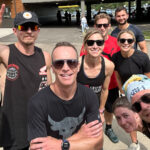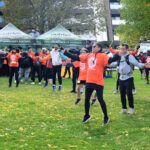I had just set out along Gatineau Park’s gorgeous Wolf Trail when my foot caught on something and I went crashing to the ground.
I was surprised only because I had not expected my fears of trail running to be realized before I’d even lost sight of the parking lot.
While I log a lot of miles on roads, multi-use pathways, tracks and treadmills, I tend to avoid the trails. I usually have a road race on the calendar and a training plan to follow — one that doesn’t tell me to go trail running. Plus, I have suspected that attempts at trail running will lead to injury.
But on a beautiful fall day last month, I decided to give trail running a try. After that first face plant I stayed upright — though there were several close calls. I was slow going up the hills and even slower coming down.

The trail was beautiful and I loved the opportunity to go exploring amidst the fall colours, but my training on the roads had not prepared me for the 8.5-kilometre trail run with a modest 330 metres of elevation. After returning home I reached out to Saskatoon trail ultra runner James Beer and asked him what advice he’d give to new trail runners like me.
Beer has been running since 2011 and turned to the trails in 2018. He won his first ever trail race — the 2018 Deadfall 50 in the Qu’Appelle Valley — and has also landed on the podium in the 2019 Black Spur Ultra in Kimberley, B.C., the 2019 EcoTrail Wicklow 45-kilometre race in Bray, Ireland and the 2021 Bigfoot 50 in White Butte. He was in the news last year when he ran a half marathon every day in December to raise money for the Saskatoon Food Bank.

Here’s the advice I wish I’d heard from Beer before I hit the trails:
- When transitioning from the roads to the trails you want to slow down. It takes time to get used to running on uneven surfaces with obstacles to watch out for. Don’t get discouraged if it takes you longer to cover the same distance on the trails than it does on the trail. That is normal.
- Shorten your stride and you will become much more agile on the trails which is especially important on more technical trails. You will then be able to lengthen your stride when needed to avoid an obstacle.
- Keep your eyes forward scanning 10 to 15 feet up the trail so you are able to navigate efficiently without tripping, falling or running into an obstacle. It’s important to stay attentive to foot placement as there may be rocks, roots, trees and sharp turns to navigate. You will be more mentally engaged when running on the trails.
- Invest in a proper pair of trail runners. It is important that you get a pair that fits properly and are comfortable on your feet. There are many running shoe brands and within the brands there are different types of trail shoes for different types of terrain and conditions. It is best to hit up your local specialty running store as the sales staff will be educated on their products and in turn will be able to get you into the right trail shoe for your particular needs
- When running uphill you want to shorten your stride even more. Short quick strides will be much more efficient and it also helps to avoid muscle and tendon strains. On long, steep inclines it may be much more efficient to power hike. With a little practice you can almost maintain a similar pace with less energy output
- When running downhill you want to have quick feet with good leg turnover. Light on your feet with a good cadence is another way of putting it. Again you don’t want to look straight down at your feet, but rather look ahead on the trail scanning for obstacles to avoid. Let gravity do the work. You want to use your upper body to provide balance. Keep your shoulders and arms relaxed, allowing them to move up and down in a flapping motion to maintain your balance. Again it must be noted that you learn this skill by starting out slow and, as you practice and get more confident, you can attempt to go faster.
- The most important thing to remember when trail running is to have fun!!

Thanks to Beer for his tips. I don’t know when I’ll next hit the trails, but when I do I’ll be sure to power hike up the steep hills and scan the ground a bit further ahead of me.









